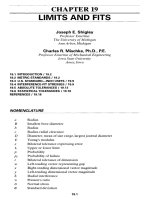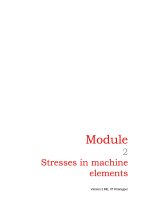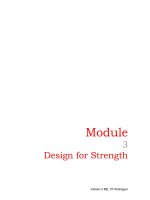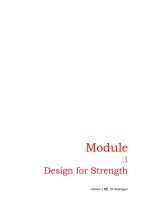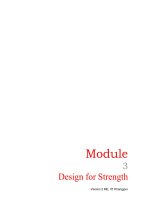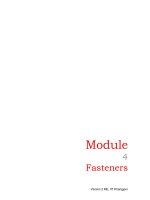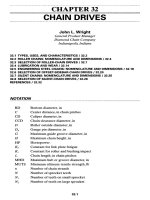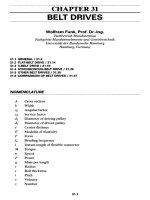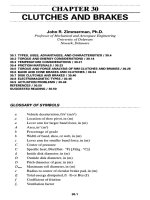Tài liệu Handbook of Machine Design P45 doc
Bạn đang xem bản rút gọn của tài liệu. Xem và tải ngay bản đầy đủ của tài liệu tại đây (993.39 KB, 30 trang )
CHAPTER
38
VIBRATION
AND
CONTROL
OF
VIBRATION
T.
S.
Sankar,
Ph.D.,
Eng.
Professor
and
Chairman
Department
of
Mechanical
Engineering
Concordia
University
Montreal,
Quebec,
Canada
R.
B.
Bhat,
Ph.D.
Associate
Professor
Department
of
Mechanical
Engineering
Concordia
University
Montreal,
Quebec,
Canada
38.1
INTRODUCTION
/
38.1
38.2
SINGLE-DEGREE-OF-FREEDOM
SYSTEMS
/
38.1
38.3
SYSTEMS
WITH
SEVERAL
DEGREES
OF
FREEDOM
/38.19
38.4
VIBRATION
ISOLATION
/
38.28
REFERENCES
/
38.30
38.1 INTRODUCTION
Vibration analysis
and
control
of
vibrations
are
important
and
integral aspects
of
every machine design procedure. Establishing
an
appropriate mathematical model,
its
analysis, interpretation
of the
solutions,
and
incorporation
of
these results
in the
design, testing, evaluation, maintenance,
and
troubleshooting require
a
sound under-
standing
of the
principles
of
vibration.
All the
essential materials dealing with vari-
ous
aspects
of
machine vibrations
are
presented here
in a
form
suitable
for
most
design applications. Readers
are
encouraged
to
consult
the
references
for
more
details.
38.2
SINGLE-DEGREE-OF-FREEDOMSYSTEMS
38.2.1
Free
Vibration
A
single-degree-of-freedom
system
is
shown
in
Fig.
38.1.
It
consists
of a
mass
m
con-
strained
by a
spring
of
stiffness
k, and a
damper with viscous damping
coefficient
c.
The
stiffness
coefficient
k is
defined
as the
spring force
per
unit deflection.
The
coef-
FIGURE
38.1
Representation
of a
single-degree-
of-freedom
system.
ficient
of
viscous damping
c is the
force provided
by the
damper opposing
the
motion
per
unit velocity.
If
the
mass
is
given
an
initial displacement,
it
will start vibrating about
its
equi-
librium
position.
The
equation
of
motion
is
given
by
mx
+
cjc
+ kx = O
(38.1)
where
x is
measured
from
the
equilibrium position
and
dots above variables repre-
sent differentiation with respect
to
time.
By
substituting
a
solution
of the
form
x =
e
81
into
Eq.
(38.1),
the
characteristic equation
is
obtained:
ms
2
+ cs + k =
Q
(38.2)
The two
roots
of the
characteristic equation
are
S
=
^tZCO
n
(I-CT
2
(38.3)
where
O)
n
=
(klm)
m
is
undamped natural
frequency
£
=
clc
c
is
damping
ratio
c
c
=
2/TtCQ
n
is
critical
damping
coefficient
«=v-i
Depending
on the
value
of
£,
four
cases arise.
Undamped
System
(£=
O).
In
this case,
the two
roots
of the
characteristic equation
are
s
=
±m
n
=
±i(klm)
m
(38.4)
and
the
corresponding solution
is
x = A cos
GV
+ B sin GV
(38.5)
where
A and B are
arbitrary constants depending
on the
initial conditions
of the
motion.
If the
initial displacement
is
Jt
0
and
the
initial velocity
is
V
0
,
by
substituting
these values
in Eq.
(38.5)
it is
possible
to
solve
for
constants
A and B.
Accordingly,
the
solution
is
VQ
x =
Jt
0
cos GV + — sin GV
(38.6)
03«
Here,
G)
n
is the
natural frequency
of the
system
in
radians
per
second (rad/s), which
is
the
frequency
at
which
the
system executes
free
vibrations.
The
natural
frequency
is
/.=£
(38.7)
where
f
n
is in
cycles
per
second,
or
hertz
(Hz).
The
period
for one
oscillation
is
T=|
=
-
W
fn
CO
n
The
solution given
in Eq.
(38.6)
can
also
be
expressed
in the
form
jt
=
^cos(co
n
-6)
(38.9)
where
X=
\xl+(
—
}
2
]
112
9
=
tan-
1
^-
(38.10)
L
\
co
n
/
J
CO
n
^
0
The
motion
is
harmonic with
a
phase angle
0 as
given
in Eq.
(38.9)
and is
shown
graphically
in
Fig. 38.4.
UnderdampedSystem
(O
<£<
1).
When
the
system damping
is
less than
the
criti-
cal
damping,
the
solution
is
x =
[exp(-^GV)]
(A cos GV + B sin GV)
(38.11)
where
co,
=
co
n
(l-C
2
)"
2
(38.12)
is
the
damped natural frequency
and A and B are
arbitrary constants
to be
deter-
mined
from
the
initial conditions.
For an
initial amplitude
of
Jt
0
and
initial velocity
V
0
,
x =
[exp
(-CcO
n
Ol
I
*o
cos
co/
+
——
sin GV
(38.13)
V
co,
/
which
can be
written
in the
form
x
=
[exp
(-^OV)]
X cos
(co/
-
6)
x
L-^ft
m
'*
o+v
°Yr
(3814)
^T
0+
I
co,
JJ
and
e.ta^itetZo
CO,
An
underdamped system will execute exponentially decaying oscillations,
as
shown
graphically
in
Fig. 38.2.
FIGURE
38.2 Free
vibration
of an
underdamped
single-degree-of-freedom
system.
The
successive maxima
in
Fig. 38.2 occur
in a
periodic fashion
and are
marked
XQ,
Xi
9
X
2
,
The
ratio
of the
maxima separated
by n
cycles
of
oscillation
may be
obtained
from
Eq.
(38.13)
as
^
=
exp(-»6)
(38.15)
^O
where
,_
27CC
(1-O"
2
is
called
the
logarithmic decrement
and
corresponds
to the
ratio
of two
successive
maxima
in
Fig. 38.2.
For
small values
of
damping, that
is,
£
«
1, the
logarithmic
decrement
can be
approximated
by
6
=
27iC
(38.16)
Using this
in Eq.
(38.14),
we
find
^-
=
exp
(-2roiQ
-
1 -
2iwC
(38.17)
AO
FIGURE 38.3 Variation
of the
ratio
of
displacement maxima with damping.
The
equivalent viscous damping
in a
system
is
measured experimentally
by
using
this
principle.
The
system
at
rest
is
given
an
impact which provides initial velocity
to
the
system
and
sets
it
into
free
vibration.
The
successive maxima
of the
ensuing
vibration
are
measured,
and by
using
Eq.
(38.17)
the
damping ratio
can be
evalu-
ated.
The
variation
of the
decaying amplitudes
of
free
vibration with
the
damping
ratio
is
plotted
in
Fig. 38.3
for
different
values
of n.
Critically
Damped
System
(£
= 1).
When
the
system
is
critically damped,
the
roots
of
the
characteristic equation given
by Eq.
(38.3)
are
equal
and
negative real quanti-
ties.
Hence,
the
system does
not
execute oscillatory
motion.
The
solution
is of the
form
jc
= (A +
Bf)
exp
(-CO
n
O
(38.18)
and
after
substitution
of
initial conditions,
x=[x
0
+
(v
0
+
X^
n
)I]
exp
(-GV)
(38.19)
This motion
is
shown graphically
in
Fig. 38.4, which gives
the
shortest time
to
rest.
Overdamped
System
(£>
1).
When
the
damping
ratio
£
is
greater than
unity,
there
are two
distinct negative real roots
for the
characteristic equation given
by Eq.
(38.3).
The
motion
in
this case
is
described
by
jc
-
exp
KGV)
[A
exp
co
n
A/C
2
- 1 + B exp
(-GvV£
2
-
I)]
(38.20)
FIGURE 38.4
Free
vibration
of a
single-degree-of-freedom
system
under
different values
of
damping.
where
1
/
V
0
+
^
n
X
0
\ 1
fx
0
+^
n
X
0
\
A.
=
—
[Xn
+
D
— — [
2\
co
n
/
2
\
CO
0
/
and
CO
0
-
CO
n
V^
2
- 1
All
four
types
of
motion
are
shown
in
Fig. 38.4.
If
the
mass
is
suspended
by a
spring
and
damper
as
shown
in
Fig. 38.5,
the
spring
will
be
stretched
by an
amount
5
sf
,
the
static deflection
in the
equilibrium position.
In
such
a
case,
the
equation
of
motion
is
mx
+
ex+
k(x +
8rf)
= mg
(38.21)
FIGURE 38.5 Model
of a
single-degree-of-
freedom
system showing
the
static deflection
due to
weight.
Since
the
force
in the
spring
due to the
static equilibrium
is
equal
to the
weight,
or
k$
st
=
mg
=
W,
the
equation
of
motion reduces
to
mx
+
ex+
kx =
Q
(38.22)
which
is
identical
to Eq.
(38.1).
Hence
the
solution
is
also similar
to
that
of Eq.
(38.1).
In
view
of Eq.
(38.21)
and
since
CQ
n
=
(klrri)
112
,
the
natural frequency
can
also
be
obtained
by
/ K
\
112
CO
n
=
(-J-)
(38.23)
\<w
An
approximate value
of the
fundamental natural frequency
of any
complex
mechanical
system
can be
obtained
by
reducing
it to a
single-degree-of-freedom
sys-
tem.
For
example,
a
shaft
supporting several disks (wheels)
can be
reduced
to a
single-degree-of-freedom
system
by
lumping
the
masses
of all the
disks
at the
center
and
obtaining
the
equivalent
stiffness
of the
shaft
by
using simple flexure theory.
38.2.2
Torsional
Systems
Rotating
shafts
transmitting torque will experience torsional vibrations
if the
torque
is
nonuniform,
as in the
case
of an
automobile crankshaft.
In
rotating
shafts
involving gears,
the
transmitted torque
will
fluctuate because
of
gear-mounting
errors
or
tooth profile errors, which will result
in
torsional vibration
of
the
geared
shafts.
A
single-degree-of-freedom torsional system
is
shown
in
Fig. 38.6.
It has a
mass-
less
shaft
of
torsional
stiffness
k,
a
damper with damping coefficient
c, and a
disk
with
polar mass moment
of
inertia
/.
The
torsional
stiffness
is
defined
as the
resist-
ing
torque
of the
shaft
per
unit
of
angular twist,
and the
damping coefficient
is the
resisting
torque
of the
damper
per
unit
of
angular velocity.
Either
the
damping
can
be
externally applied,
or it can be
inherent
structural damping.
The
equation
of
motion
of the
system
in
torsion
is
given
/e
+
c9
+
£0
=
0
(38.24)
FIGURE 38.6
A
representation
of a
one-
freedom
torsional system.
Equation (38.24)
is in the
same form
as Eq.
(38.1),
except that
the
former deals with
moments whereas
the
latter deals with forces.
The
solution
of Eq.
(38.24) will
be of
the
same
form
as
that
of Eq.
(38.1),
except that
/
replaces
m and
k
and c
refer
to
tor-
sional
stiffness
and
torsional damping coefficient.
38.2.3
Forced
Vibration
System
Excited
at the
Mass.
A
vibrating system with
a
sinusoidal force acting
on
the
mass
is
shown
in
Fig. 38.7.
The
equation
of
motion
is
mx
+
cx+kx
=
F
0
sin
otf
(38.25)
Assuming that
the
steady-state response lags behind
the
force
by an
angle
6, we see
that
the
solution
can be
written
in the
form
x
s
= X sin
(cor
-9)
(38.26)
FIGURE 38.7 Oscillating force F(t) applied
to
the
mass.
Substituting
in Eq.
(38.26),
we
find
that
the
steady-state
solution
can be
obtained:
(F,/*)
sin
(a*-9)
Xs
[(l-(o
2
/(B
2
)
2
+
№(o
n
)
2
]''
2
(
™-
Z/>
Using
the
complementary
part
of the
solution
from
Eq.
(38.19),
we see
that
the
com-
plete
solution
is
x
=
x
s
+
exp
(-Co)
n
O
[A exp
(oy
V^T)
+ B exp
(-oy
V^
2
-
I)]
(38.28)
If
the
system
is
undamped,
the
response
is
obtained
by
substituting
c = O in Eq.
(38.25)
or
£
= O in Eq.
(38.28). When
the
system
is
undamped,
if the
exciting fre-
quency
coincides with
the
system natural frequency,
say
co/co«
=
1.0,
the
system
response will
be
infinite.
If the
system
is
damped,
the
complementary part
of the
solution decays exponentially
and
will
be
nonexistent
after
a few
cycles
of
oscilla-
tion; subsequently
the
system response
is the
steady-state response.
At
steady state,
the
nondimensional response amplitude
is
obtained
from
Eq.
(38.27)
as
JLJ(Iz^Y
+
№Yf
(38
.
29)
FJk
|_\
®n
I
\
CO
n
/
J
and
the
phase between
the
response
and the
force
is
9
=
tan~'-^
(38.30)
1
-
C0
2
/C0
n
When
the
forcing
frequency
co
coincides
with
the
damped
natural
frequency
co
rf
,
the
response
amplitude
is
given
by
Y 1
^
max
_
/^Q
^l
\
F
0
/£~£(4-3C
2
)
1/2
V*'*
L)
The
maximum response
or
resonance occurs when
co
=
CO
n
(I
-
2£
2
)
1/2
and is
X
1
jjk
=
2t;(i-t;
2
)
m
(3832)
For
structures with
low
damping,
co
rf
approximately equals
co
n
,
and the
maximum
response
is
Y 1
^
max
x
(^o
^\
F
0
Ik
~2C
(38
'
33)
The
response amplitude
in Eq.
(38.29)
is
plotted against
the
forcing frequency
in
Fig.
38.8.
The
curves start
at
unity, reach
a
maximum
in the
neighborhood
of the
system
natural frequency,
and
decay
to
zero
at
large values
of the
forcing frequency.
The
response
is
larger
for a
system with
low
damping,
and
vice versa,
at any
given fre-
quency.
The
phase difference between
the
response
and the
excitation
as
given
in
Eq.
(38.30)
is
plotted
in
Fig.
38.9.
For
smaller forcing frequencies,
the
response
is
nearly
in
phase with
the
force;
and in the
neighborhood
of the
system natural fre-
quency,
the
response lags behind
the
force
by
approximately 90°.
At
large values
of
forcing
frequencies,
the
phase
is
around
180°.
FREQUENCY
RATIO
w/u>
n
FIGURE
38.8
Displacement-amplitude
frequency
response
due to
oscil-
lating
force.
Steady-State
Velocity
and
Acceleration Response.
The
steady-state velocity
response
is
obtained
by
differentiating
the
displacement response, given
by Eq.
(38.27),
with respect
to
time:
*'
=
^
(3834)
F^
n
Ik
[(I
-
co
2
/co
2
)
2
+
(2£co/CG,0
2
]
1/2
V
'
And the
steady-state acceleration response
is
obtained
by
further differentiation
and is
**
(<°
/c
O
2
/*o
W
F^
n
Ik
[(I
-
co
2
/co
2
)
2
+
(2Cco/co
n
)
2
]
1/2
^
5
'^
;
These
are
shown
in
Figs.
38.10
and
38.11
and
also
can be
obtained directly
from
Fig.
38.8
by
multiplying
the
amplitude
by
co/co
n
and
(co/co«)
2
,
respectively.
Force
Transmissibility.
The
force
F
T
transmitted
to the
foundation
by a
system
subjected
to an
external harmonic excitation
is
F
T
=cx+kx
(38.36)
AMPLITUDE RATIO
xk/F
Q
FREQUENCY
RATIO
uj/a>
FIGURE
38.9
Phase-angle
frequency
response
for
forced
motion.
Substituting
the
system response
from
Eq.
(38.27) into
Eq.
(38.36)
gives
^-rsin(co^-0)
(38.37)
FQ
where
the
nondimensional magnitude
of the
transmitted
force
T is
given
by
r
i
+
(2^/co
B
)
2
I*
r
-|_(l-«
2
/^)
2
+
(2Cco/co
n
)
2
J
(3838)
and the
phase between
F
T
and
F
0
is
given
by
9
=
tan-'
^fff
2/2
(38.39)
1 -
coVco
2
+
4C
2
CoVo)J
The
transmissibility
T is
shown
in
Fig. 38.12 versus forcing frequency.
At
very
low
forcing
frequencies,
the
transmissibility
is
close
to
unity, showing that
the
applied
force
is
directly transmitted
to the
foundation.
The
transmissibility
is
very large
in
the
vicinity
of the
system natural frequency,
and for
high forcing frequencies
the
transmitted
force
decreases considerably.
The
phase variation between
the
transmit-
ted
force
and the
applied force
is
shown
in
Fig.
38.13.
Rotating Imbalance. When machines with rotating imbalances
are
mounted
on
elastic
supports, they constitute
a
vibrating system subjected
to
excitation
from
the
PHASE ANGLE
9
(DEGREES)
FREQUENCY
RATIO
u/uj
FIGURE
38.10
Velocity
frequency
response.
rotating
imbalance.
If the
natural frequency
of the
system coincides with
the
fre-
quency
of
rotation
of the
machine imbalance,
it
will
result
in
severe vibrations
of the
machine
and the
support structure.
Consider
a
machine
of
mass
M
supported
as
shown
in
Fig.
38.14.
Let the
imbal-
ance
be a
mass
m
with
an
eccentricity
e and
rotating with
a
frequency
GD.
Consider
the
motion
x of the
mass
M-m,
with
x
m
as the
motion
of the
unbalanced mass
m
rel-
ative
to the
machine mass
M. The
equation
of
motion
is
(M
-
m)'x
+
m(x
+
x
m
)
+
ex+
kx =
O
(38.40)
The
motion
of the
unbalanced mass relative
to the
machine
is
x
m
=
e sin cor
(38.41)
Substitution
in Eq.
(38.40) leads
to
Mx
+
cx+kx
=
me®
2
sin
cor
(38.42)
VELOCITY
RATIO
xk/FgO)
FREQUENCY
RATIO
u/u>
n
FIGURE
38.11 Acceleration
frequency
response.
This equation
is
similar
to Eq.
(38.25), where
the
force
amplitude
F
0
is
replaced
by
weco
2
.
Hence,
the
steady-state solution
of Eq.
(38.42)
is
similar
in
form
to Eq.
(38.27)
and is
given nondimensionally
as
x M
_
((0/(Q
n
)
2
SJn(CQr-G)
em
[(I
-
CoV(Q
2
O
2
+
(2Cco/co
n
)
2
]
1/2
{
}
where
tan
9
=-^
1
(38.44)
1
-
CQ
2
/C0
2
'
Note that since
the
excitation
is
proportional
to
co
2
,
the
response
has an
co
2
term
in
the
numerator
and
resembles
the
acceleration response
of a
system subjected
to a
force
of
constant magnitude, given
by Eq.
(38.35).
The
complete solution consists
of
the
complementary part
of the
solution
and is
ACCELERATION RATIO
xk/F^
FREQUENCY
RATIO
w/w
n
FIGURE
38.12
Transmissibility
plot.
x
=
exp
-CGV
{A
exp
[(?
-
1)
1/2
oy]
+
5
exp
[-(£
2
-
1)
1/2
ov]}
mg(cQ/co
n
)
2
sin(cor-e)
M[(l
-
G)
2
/co
2
)
2
+
(2Cco/co«)
2
]
1/2
^
;
System
Excited
at the
Foundation. When
the
system
is
excited
at the
foundation,
as
shown
in
Fig.
38.15,
with
a
certain displacement
u(f)
=
U
0
sin
otf,
the
equation
of
motion
can be
written
as
mx
+
c(x
-
u)
+ k(x -
u)
=
O
(38.46)
This equation
can be
written
in the
form
mx +
ex+
kx
=
Cw
0
CO
cos
otf
+
ku
0
sin
co?
(38.47)
=
F
0
sin
(cor
+
0)
TRANSMISSIBILITY
T
FREQUENCY
RATIO
u/u>
n
FIGURE 38.13 Phase angle between transmitted
and
applied forces.
FIGURE 38.14 Dynamic system
subj
ect to un-
balanced excitation.
PHASE ANGLE
<J>
(DEGREES)
FIGURE
38.15
A
base excited system.
where
F
Q
=
U
0
(k
2
+
c
2
co
2
)
1/2
(38.48)
and
4>
=
tan-
1
—
(38.49)
CCO
Equation (38.47)
is
identical
to Eq.
(38.25) except
for the
phase
§.
Hence
the
solu-
tion
is
similar
to
that
of Eq.
(38.25).
If the
ratio
of the
system response
to the
base
displacement
is
defined
as the
motion transmissibility,
it
will have
the
same form
as
the
force transmissibility given
in Eq.
(38.38).
Resonance, System
Bandwidth,
and Q
Factor.
A
vibrating system
is
said
to be in
resonance when
the
response
is
maximum.
The
displacement
and
acceleration
responses
are
maximum when
CO
=
CO
n
(I-2£
2
)
1/2
(38.50)
whereas velocity response
is
maximum when
CO-CO
n
(38.51)
In the
case
of an
undamped system,
the
response
is
maximum when
co
=
co
n
,
where
co
n
is the
frequency
of
free
vibration
of the
system.
For a
damped system,
the
fre-
quency
of
free
oscillations
or the
damped natural frequency
is
given
by
co,
=
CO
n
(I-C
2
)
1
'
2
(38.52)
In
many mechanical systems,
the
damping
is
small
and the
resonant frequency
and
the
damped natural frequency
are
approximately
the
same.
When
the
system
has
negligible damping,
the
frequency response
has a
sharp
peak
at
resonance;
but
when
the
damping
is
large,
the
frequency
response
near
res-
onance will
be
broad,
as
shown
in
Fig. 38.8.
A
section
of the
plot
for a
specific damp-
ing
value
is
given
in
Fig.
38.16.
The Q
factor
is
defined
as
Q
=
^=R
ma
,
(38.53)
FREQUENCY
FIGURE 38.16
Resonance,
bandwidth,
and Q
factor.
which
is
equal
to the
maximum response
in
physical systems with
low
damping.
The
bandwidth
is
defined
as the
width
of the
response curve measured
at the
"half-
power" points, where
the
response
is
/?
max
A/2.
For
physical systems with
£
<
0.1,
the
bandwidth
can be
approximated
by
ACO
=
2CcO
n
=
-^
(38.54)
Forced
Vibration
of
Torsional
Systems.
In the
torsional system
of
Fig. 38.3,
if the
disk
is
subjected
to a
sinusoidal external torque,
the
equation
of
motion
can be
writ-
ten as
/0 +
c6
+
A:0
=
T
0
sin
otf
(38.55)
Equation (38.55)
has the
same form
as Eq.
(38.25). Hence
the
solution
can be
obtained
by
replacing
m by
/
and
F
0
by
T
0
and by
using torsional
stiffness
and
tor-
sional damping coefficients
for k and c,
respectively,
in the
solution
of Eq.
(38.25).
38.2.4
Numerical Integration
of
Differential Equations
of
Motion:
Runge-Kutta
Method
When
the
differential equation cannot
be
integrated
in
closed form, numerical
methods
can be
employed.
If the
system
is
nonlinear
or if the
system excitation
can-
RESPONSE
not be
expressed
as a
simple analytical
function,
then
the
numerical method
is the
only
recourse
to
obtain
the
system
response.
The
differential equation
of
motion
of a
system
can be
expressed
in the
form
*=/(*,*,*)
or
x
=
y
=
F
1
(Wt)
(38.56)
y=f(x,x,i)
=
F
2
(x,y,i)
X
0
=
X(Q)
X
0
=
X(Q)
where
Jt
0
and
X
0
are the
initial displacement
and
velocity
of the
system, respectively.
The
form
of the
equation
is the
same whether
the
system
is
linear
or
nonlinear.
Choose
a
small time interval
h
such that
tj=jh
for
;
=
0,1,2,
Let
Wy
denote
an
approximation
to
Jt
1
-
(t
}
)
for
each
;
=
0,1,2,
and
/
=
1,2.
For the
initial conditions,
set
H>I,
O
=
*o
and
w
2
,o
=
X
0
.
Obtain
the
approximation
Wy
+
\
y
given
all
the
values
of the
previous steps
w^
as
[38.1]
Wy
+1
=
Wy
+ -
(k
u
+
2k
24
+
2k
3
j
+ fcy)
i
=
l,2
(38.57)
where
k
u
=
HF
1
(I
1
+
Wi
j9
W
2
J)
k
2
,t
=
hF(
tj
+
—,
W
1
J
+ - fc
u
,
w
2ij
+ -
k
ia
V
2 2 2
'
(38.58)
k
34
=
HF
1
Uj
+
—,
W
1
J
+ -
&
2
,i,
w
2?/
+ -
k
2
,
2
j
k
4ti
=
HF
1
(Ij
+
h,
WU
+
fe,i»
W
2
,/
+
k
3
t)
i =
l,2
Note that
/c
u
and
k
12
must
be
computed before
we can
obtain
/c
2
,i.
Example.
Obtain
the
response
of a
generator rotor
to a
short-circuit disturbance
given
in
Fig.
38.17.
The
generator
shaft
may be
idealized
as a
single-degree-of-freedom
system
in
torsion with
the
following
values:
CO
1
=
1737
cpm =
28.95(2Ti)
rad/s
= 182
rad/s
/ =
8.5428
Ib
• in • s
2
(25 kg •
m
2
)
k =
7.329
x
10
6
Ib
-
in/rad (828
100 N
-
m/rad)
Solution
/6
+
kQ
=
/(O
6
=
y
9
+
^
Hence,
9
=
<|>
<j)
=
y-0
+
^
(38.59)
where f(t)
is
tabulated.
Since
coi
= 182
rad/s,
the
period
i
=
2rc/182
=
0.00345
s and the
time interval
h
must
be
chosen
to be
around 0.005
s.
Hence, tabulated values
of
f(t)
must
be
available
for
t
intervals
of
0.005
s, or it has to be
interpolated
from
Fig.
38.17.
FIGURE
38.17
Short-circuit excitation form.
38.3
SYSTEMSWITHSEVERAL
DEGREES
OF
FREEDOM
Quite often,
a
single-degree-of-freedom
system model does
not
sufficiently
describe
the
system vibrational behavior. When
it is
necessary
to
obtain information regard-
ing
the
higher natural frequencies
of the
system,
the
system must
be
modeled
as a
multidegree-of-freedom
system. Before discussing
a
system with several degrees
of
freedom,
we
present
a
system with
two
degrees
of
freedom,
to
give
sufficient
insight
into
the
interaction between
the
degrees
of
freedom
of the
system. Such
interaction
can
also
be
used
to
advantage
in
controlling
the
vibration.
38.3.1
System
with
Two
Degrees
of
Freedom
Free
Vibration.
A
system with
two
degrees
of
freedom
is
shown
in
Fig.
38.18.
It
consists
of
masses
Jn
1
and
W
2
,
stiffness
coefficients
ki
and
A;
2
,
and
damping
coeffi-
cients
C
1
and
C
2
.
The
equations
of
motion
are
W
1
Jt
1
+
(GI
+
C
2
)Xi
+
(ki
+
/T
2
)Jt
1
-
C
2
Jt
2
-
k
2
x
2
= O
(38.60)
W
2
JC
2
+
C
2
X
2
+
/C
2
JC
2
-
C
2
Jt
1
-
/C
2
JC
1
=
O
FIGURE 38.18 Two-degree-of-freedom system.
Assuming
a
solution
of the
type
X
1
=Ae*
x
2
=
Be
st
(38.61)
and
substituting into Eqs. (38.60) yield
Fm
1
S
2
+
(C
1
+
C
2
)S
+
ki
+
k
2
]A
-
(c
2
s
+
k
2
)B
= O
(38.62)
-
(k
2
+
c
2
s)A
+
(m
2
s
2
+
c
2
s
+
k
2
)B
=
Q
Combining Eqs. (38.62),
we
obtain
the
frequency equation
Jm
1
S
2
+
(C
1
+
c
2
)s
+
ki
+
k
2
]
(m
2
s
2
+
c
2
s
+
k
2
)
-
(c
2
s
+
k
2
)
2
= O
(38.63)
This
is a
fourth-degree polynomial
in s, and it has
four
roots; hence,
the
complete
solution will consist
of
four
constants which
can be
determined
from
the
four
initial
conditions
Je
1
,
Jc
2
,
Jc
1
,
and
X
2
.
If
damping
is
less than critical, oscillatory motion occurs,
and
all
four
roots
of Eq.
(38.63)
are
complex with negative real parts,
in the
form
Si,2
=
~n\
±
ipi
s
3
,4
=
-«2
±
IP2
(38.64)
So
the
complete solution
is
Je
1
= exp
(-nit)
(Ai
cos
pit+A
2
sin/J
1
J)
+
exp
(-n
2
t)
(Bi
cos
p
2
t
+
B
2
sin
p
2
t)
(38.65)
Je
2
= exp
(-nit)
(A{
cos
pit
+
A
2
sin
pit)
+
exp
(-«
2
0
(Bi
cosp
2
t
+
B
2
sinp
2
t)
Since
the
amplitude ratio
AIB is
determined
by Eq.
(38.62), there
are
only
four
inde-
pendent constants
in Eq.
(38.65) which
are
determined
by the
initial conditions
of
the
system.
Forced
Vibration. Quite
often
an
auxiliary spring-mass-damper system
is
added
to
the
main system
to
reduce
the
vibration
of the
main system.
The
secondary system
is
called
a
dynamic absorber. Since
in
such cases
the
force acts
on the
main system only,
consider
a
force
P sin
cor
acting
on the
primary mass
m.
Referring
to
Fig.
38.18,
we
see
that
the
equations
of
motion
are
miXi
+
(C
1
+
C
2
)Jt
1
+
(ki
+
k
2
)xi
-
C
2
X
2
-
k
2
x
2
= P sin
cor
(38.66)
Jn
2
X
2
+
C
2
X
2
+
k
2
x
2
-
C
2
Xi
-
k
2
Xi
=
O
Assuming
a
solution
of the
type
=
A
1
cos
cor+A
2
sin
cor
P/KI
(38.67)
=
A
3
cos
cor+A
4
sin cor
P/KI
and
substituting into Eqs. (38.66),
we
find
that
the
A
1
-
are
given
as
Co!
[2D
1
CoC
2
CQ
2
-
Z)
2
(CQ
2
-
co
2
)]
Dl
+
Dl
A
CQ^
[Z)
1
(CQJ-co
2
)+
2Z)
2
CoC
2
CQ
2
]
A2
-
Z)
2
1
+
Z)i
(38.68)
03!(2Z)
1
CoC
2
CO
2
-Z)
2
CQ
2
Q
/>?
+
/>i
CoKZ)
1
COJ+
2D
2
CoC
2
CQ
2
)
A4
~
Oi
+
Dl
where
Z)
1
=
(co
2
-
co
2
,)
(co
2
-
co
2
!
-
iLico
2
,)
-
4CO
2
C
2
CO
2
(CiCO
1
+
1ICzCO
2
)
-
Li(Co
2
4
-
4G)
2
C
2
COi)
(38.69)
Z)
2
=
2co[(coi
-
co
2
)
(C
1
CO
1
+
!^C
2
CO
2
)
+
CzCO
2
(COi
-
co
2
+
p,a>i)
-
2|iC
2
coi]
2
ki
2
k
2
co?
= —
coi
= —
mi
m
2
^
=
^
1
-
£2
=
~-
(
38
-
7
0)
b
2m!COi
^m
2
CO
2
v
'
m
2
^=W
Responses
may
also
be
written
in the
form
Jc
1
=
B
1
sin
(cor
-
G
1
)
X
2
=
B
2
sin
(cor
-
0
2
)
(38.71)
where
B,
=
(A\
+
Al)
m
B
2
=
(Al
+
AlY
12
(38.72)
tan
GI
= -
—-
tan
6
2
=
-
-~r
A
2
A
4
Here
0i
and
G
2
are the
phase angles
by
which
the
responses
of
masses
mi
and ra
2
,
respectively,
will
lag
behind
the
applied force.
The
response amplitudes
BI
and
B
2
are
plotted
in
Figs. 38.19
and
38.20, respectively.
The
amplitude
BI
has a
minimum
between
CO
1
and
CO
2
.
The
equations
of
motion
for
torsional systems with
2
degrees
of
freedom have
the
same
form
as
Eqs. (38.60)
and
(38.66).
The
solution will also
be
similar
and
will
exhibit
the
same characteristics
as
discussed earlier.
38.3.2
Multidegree-of-Freedom
Systems
In
many applications,
it is
necessary
to
know several higher modes
of a
vibrating
system
and
evaluate
the
vibration response.
Here,
the
elastic system
has to be
treated
as one
with distributed mass
and
elasticity. This
is
possible
for
simple ele-
ments such
as
beams, plates,
or
shells
of
regular geometry. However, when
the
struc-
tural
system
is
complex,
it may be
modeled
as a
multidegree-of-freedom
discrete
FIGURE 38.19 Amplitude frequency
response
of the
mass
of a
two-
freedom
system subject
to
forced excitation.
FIGURE
38.20
Torsional
system with four freedoms.
system
by
concentrating
its
mass
and
stiffness
properties
at a
number
of
locations
on
the
structure.
The
number
of
degrees
of
freedom
of a
structure
is the
number
of
independent
coordinates needed
to
describe
the
configuration
of the
structure.
In a
lumped-mass
model,
if
motion along only
one
direction
is
considered,
the
number
of
degrees
of
freedom
is
equal
to the
number
of
masses;
and if
motion
in a
plane
is of
interest,
the
number
of
degrees
of
freedom will equal twice
the
number
of
lumped masses.
Holzer
Method.
When
an
undamped torsional system consisting
of
several disks
connected
by
shafts
vibrates
freely
in one of its
natural frequencies,
it
does
not
need
any
external torque
to
maintain
the
vibration.
In
Holzer's
method, this
fact
is
used
to
calculate
the
natural frequencies
and
natural modes
of a
vibrating system. Figure
38.20 shows
a
torsional system with several disks connected
by
shafts.
In
this proce-
dure,
an
initial value
is
assumed
for the
natural
frequency,
and a
unit amplitude
is
specified
at one
end.
The
resulting torques
and
angular displacements
are
progres-
sively
calculated
from
disk
to
disk
and
carried
to the
other end.
If the
resulting
torque
and
displacement
at the
other
end are
compatible with boundary conditions,
the
initial assumed value
for the
natural frequency
is a
correct natural frequency;
if
not,
the
whole procedure
is
repeated
with another value
for the
natural frequency
until
the
boundary conditions
are
satisfied.
For a
frequency
co
and 61 = 1, the
corre-
sponding
inertial torque
of the
first
disk
in
Fig. 38.20
is
T
1
=-J
1
Q
1
=
/!CO
2
G
1
(38.73)
This torque
is
transmitted
to
disk
2
through
shaft
1;
hence,
T
1
=
/!CO
2
G!
= fci
(G
1
-
G
2
)
(38.74)
which
relates
G
2
and
GI.
The
inertial torque
of the
second disk
is
/
2
co
2
G
2
,
and the sum
of
the
inertial torques
of
disk
1 and
disk
2 is
transmitted
to
disk
3
through
shaft
2,
which
gives
/!CO
2
G
1
+/2CO
2
G
2
=
A:
2
(G
2
-
G
3
)
(38.75)
Continuing
this process,
we see the
torque
at the far end is the
combined inertial
torques
of all the
disks
and is
given
by
T=
J^
/,G)
2
G
1
(38.76)
i
= 1
where
n is the
total number
of
disks.
If the
disk
is
free
at
that end,
the
total torque
T
should vanish.
Hence,
the
frequency
GO
which makes
T
zero
at the far end is a
natu-
ral
frequency.
Example.
Determine
the
natural frequencies
and
mode shapes
of a
torsional sys-
tem
consisting
of
three disks connected
by two
shafts.
J
1
=
1.7086
x
10
4
Ib
• in • s
2
(5 kg • m
2
)
J
2
=
3.7588
x
10
4
Ib
• in •
s
2
(11 kg •
m
2
)
J
3
=
3.4171
x
10
4
Ib
• in •
s
2
(10 kg •
m
2
)
fci =
8.8504
x
10
5
Ib
•
in/rad
(1 x
10
5
rad)
k
2
=
1.7701
x
10
6
Ib
•
in/rad
(2 x
10
5
rad)
Solution.
Holzer's
procedure
can be
carried
out in a
tabulated form
as
shown
in
Table
38.1.
Two
trials
are
shown
in
Table
38.1.
The
calculation
can be
carried
out for
more values
of
co,
and the
resulting
T
3
can be
plotted versus
CD,
as
shown
in
Fig.
38.21.
The
frequencies
at
which
T
3
= O are
then
the
natural frequencies
of the
system.
Bet-
ter
approximation
can be
obtained
by
employing
the
method
of
false
position
[38.1];
if
o)(+)
and
co(-)
are the
frequencies when
the
torque
has
corresponding values
of
T
3
(+)
and
r
3
(-),
the
natural frequency
can be
obtained
by
TABLE
38.1
Holzer's Procedure
Station
Frequency,
I
rad/s
1 2 3
w
e T =
Jw
2
O
°
=
*
~
~K
T
=
T +
Ju
2
O
°
=
$
~ tf T - T
H-
A>
2
0
1
111
211
2122
3222 3233
10
1.0
4425.2
0.995
1412.0
0.987
22847.0
(500.0)
(1594.5)
(2581.5)
20
1.0
17701.0
0.980
55864.0
0.948
89442.0
(2000.0)
(6312.0)
(10106.0)
co(-)T
3
(
+
)-co(
+
)r
3
(-)
r
3
(+)-r
3
(-)
The
mode shape corresponding
to a
natural frequency
can be
obtained
by
recalcu-
lating
the
values
of
O
1
,
G
2
,
and
G
3
in the
Holzer table.
In the
example,
the
first
natural
frequency
is
COi
=
141.4214
rad/s,
and the
corresponding mode shape
is
{01,62,63}
=
{!A
0.0,
-0.5}
FIGURE
38.21 Variation
of end
torque with assumed natural
frequency.
Geared
Systems.
When
a
shaft
transmits torque
to
another through
a
gear drive
of
speed ratio
n,
it is
necessary
to
reduce
the
geared torsional system
to an
equivalent
single-shaft
system
to
find
its
natural
frequency.
The
moments
of
inertia
and the
stiff-
ness
of the
equivalent system
are
obtained through
a
consideration
of the
kinetic
and
potential energies
of the
system.
Consider
the
geared torsional system
in
Fig.
38.22«.
The
speed
of the
second
shaft
is
B
2
=
n0i-
Assuming massless gears,
we see
that
the
kinetic energy
of the
system
is
T
=
^jM
+
-^J
2
n
2
Q\
(38.77)
Thus
the
equivalent mass moment
of
inertia
of
disk
2
referred
to
shaft
1 is
n
2
J
2
.
If
disks
1 and 2 are
clamped
and a
torque
is
applied
to
gear
1,
rotating
it
through
an
angle
Q
19
there
will
be
deformations
in
both
shafts
1 and 2.
Gear
2
will
rotate through
an
angle
G
2
=
nOi.
The
potential
energy stored
in the two
shafts
is
tf
=
|M
2
i+|M
2
ei
(38.78)
Hence
the
equivalent
stiffness
of
shaft
2
referred
to
shaft
1 is
n
2
k
2
.The
equivalent
torsional system
is
shown
in
Fig.
38.22Z?,
where
the
stiffness
and
inertia
of one
side
of
the
system
are
multiplied
by the
square
of the
speed ratio
to
obtain
the
correspond-
ing
equivalent values
for
Holzer calculations.
